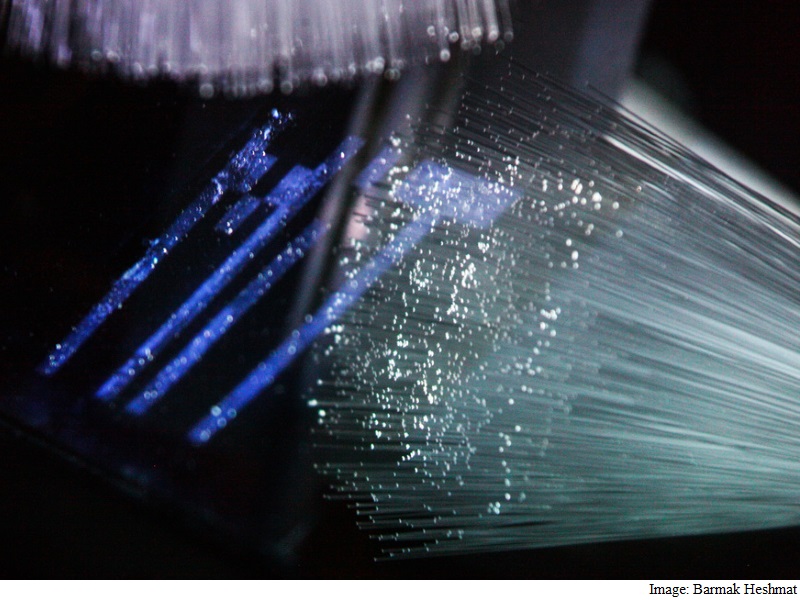- Home
- Science
- Science News
- New Imaging System Uses Optical Fibres Instead of Lenses
New Imaging System Uses Optical Fibres Instead of Lenses

Bundles of the fibres could be fed through pipes and immersed in fluids, to image oil fields, aquifers, or plumbing, without risking damage to watertight housings.
Tight bundles of the fibres could yield endoscopes with narrower diameters, since they would require no additional electronics.
The fibres are connected to an array of photosensors at one end; the other ends can be left to wave free, so they could pass individually through micrometre-scale gaps in a porous membrane, to image whatever is on the other side.
The positions of the fibres' free ends do not need to correspond to the positions of the photodetectors in the array.
By measuring the differing times at which short bursts of light reach the photodetectors - a technique known as "time of flight" - the device can determine the fibres' relative locations.
In a commercial version of the device, the calibrating bursts of light would be delivered by the fibres themselves, but in experiments with their prototype system, the researchers used external lasers.
"Time of flight, which is a technique that is broadly used in our group, has never been used to do such things," said first author Barmak Heshmat, from Massachusetts Institute of Technology (MIT), who led the new work.
"Previous works have used time of flight to extract depth information. But in this work, I was proposing to use time of flight to enable a new interface for imaging," Heshmat said.
The researchers, including Ramesh Raskar, used a bundle of 1,100 fibres that were waving free at one end and positioned opposite a screen on which symbols were projected.
The other end of the bundle was attached to a beam splitter, which was in turn connected to both an ordinary camera and a high-speed camera that can distinguish optical pulses' times of arrival.
Perpendicular to the tips of the fibres at the bundle's loose end, and to each other, were two ultrafast lasers. The lasers fired short bursts of light, and the high-speed camera recorded their time of arrival along each fibber.
Since the bursts of light came from two different directions, software could use the differences in arrival time to produce a 2D map of the positions of the fibres' tips.
It then used that information to unscramble the jumbled image captured by the conventional camera.
The study was published in the journal Nature Scientific Reports.
Catch the latest from the Consumer Electronics Show on Gadgets 360, at our CES 2026 hub.
Related Stories
- Samsung Galaxy Unpacked 2025
- ChatGPT
- Redmi Note 14 Pro+
- iPhone 16
- Apple Vision Pro
- Oneplus 12
- OnePlus Nord CE 3 Lite 5G
- iPhone 13
- Xiaomi 14 Pro
- Oppo Find N3
- Tecno Spark Go (2023)
- Realme V30
- Best Phones Under 25000
- Samsung Galaxy S24 Series
- Cryptocurrency
- iQoo 12
- Samsung Galaxy S24 Ultra
- Giottus
- Samsung Galaxy Z Flip 5
- Apple 'Scary Fast'
- Housefull 5
- GoPro Hero 12 Black Review
- Invincible Season 2
- JioGlass
- HD Ready TV
- Laptop Under 50000
- Smartwatch Under 10000
- Latest Mobile Phones
- Compare Phones
- OPPO A6 Pro 5G
- OPPO A6s
- OPPO Reno 15 Pro Max
- Honor Win RT
- Honor Win
- Xiaomi 17 Ultra Leica Edition
- Xiaomi 17 Ultra
- Huawei Nova 15
- Asus ProArt P16
- MacBook Pro 14-inch (M5, 2025)
- OPPO Pad Air 5
- Huawei MatePad 11.5 (2026)
- Xiaomi Watch 5
- Huawei Watch 10th Anniversary Edition
- Acerpure Nitro Z Series 100-inch QLED TV
- Samsung 43 Inch LED Ultra HD (4K) Smart TV (UA43UE81AFULXL)
- Asus ROG Ally
- Nintendo Switch Lite
- Haier 1.6 Ton 5 Star Inverter Split AC (HSU19G-MZAID5BN-INV)
- Haier 1.6 Ton 5 Star Inverter Split AC (HSU19G-MZAIM5BN-INV)

















